Plant Select®, a collaborative effort with Denver Botanic Gardens, Colorado State University, and regional and national horticultural professionals, is pleased to announce seven new plants to be promoted for 2011.
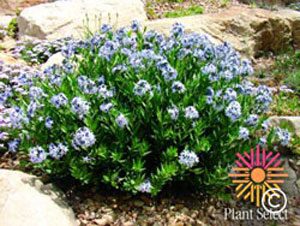 Colorado desert blue star (Amsonia jonesii) is a widely adaptable western native which thrives in ordinary gardens or unwatered xeriscapes. Sapphire blue star flowers appear from April to early summer, and the autumn foliage is a beautiful, clear yellow. This perennial plant grows 10-14” tall and 12-15” wide. It prefers full sun and well-drained soils, and is hardy to USDA zones 4-9 (up to 8,000’)
Colorado desert blue star (Amsonia jonesii) is a widely adaptable western native which thrives in ordinary gardens or unwatered xeriscapes. Sapphire blue star flowers appear from April to early summer, and the autumn foliage is a beautiful, clear yellow. This perennial plant grows 10-14” tall and 12-15” wide. It prefers full sun and well-drained soils, and is hardy to USDA zones 4-9 (up to 8,000’)
NEW TO HORTICULTURE!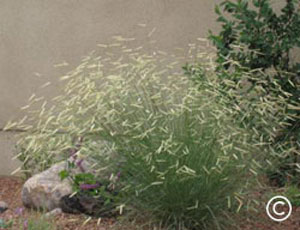 Blonde Ambition blue grama grass (Bouteloua gracilis ‘Blonde Ambition’PPAF) is a first of its kind, highly ornamental selection of Western native grass with tall, upright stems. Showy chartreuse, aging-to-blonde seed heads hold their straight shape and are displayed high above the foliage through winter, providing many months of color and texture. Developed by David Salman (High Country Gardens) this new grass is being co-introduced nationally with Plant Select®. Blonde Ambition grows 30-36″ tall and wide. Blooming July to October, it prefers full sun to partial shade in moderate to dry soils, and tolerates a wide range of soil types. This hardy native will grow in USDA zones 4-9 (up to 8,000’).
Blonde Ambition blue grama grass (Bouteloua gracilis ‘Blonde Ambition’PPAF) is a first of its kind, highly ornamental selection of Western native grass with tall, upright stems. Showy chartreuse, aging-to-blonde seed heads hold their straight shape and are displayed high above the foliage through winter, providing many months of color and texture. Developed by David Salman (High Country Gardens) this new grass is being co-introduced nationally with Plant Select®. Blonde Ambition grows 30-36″ tall and wide. Blooming July to October, it prefers full sun to partial shade in moderate to dry soils, and tolerates a wide range of soil types. This hardy native will grow in USDA zones 4-9 (up to 8,000’).
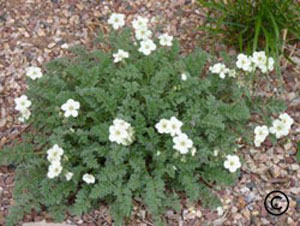 Golden Storksbill (Erodium chrysanthum) is a long lived, easy to grow, adaptable perennial with silvery mounds of evergreen, ferny foliage. Fragrant, soft yellow, geranium-like flowers appear from early spring through late summer. Golden storksbill grows 8-10” tall and 10-25” wide, and tolerates a wide range of moisture conditions (from moderate to xeric) in USDA zones 4-9 (up to 8,000’). This adaptable plant grows well in full sun to part shade and in loamy, sandy or gravelly soils
Golden Storksbill (Erodium chrysanthum) is a long lived, easy to grow, adaptable perennial with silvery mounds of evergreen, ferny foliage. Fragrant, soft yellow, geranium-like flowers appear from early spring through late summer. Golden storksbill grows 8-10” tall and 10-25” wide, and tolerates a wide range of moisture conditions (from moderate to xeric) in USDA zones 4-9 (up to 8,000’). This adaptable plant grows well in full sun to part shade and in loamy, sandy or gravelly soils
NEW TO HORTICULTURE! Avalanche white sun daisy (Osteospermum‘Avalanche’PPAF) is an all-new, extremely cold hardy perennial. Its dazzling white flowers with metallic backing are produced from April through summer over glistening mats of lustrous, nearly succulent, evergreen foliage. It has greater disease resistance and heavier summer bloom than the other hardy sun daisies. Large blossoms close at night to reveal a metallic reverse of the ray flowers. Avalanche sun daisy grows 8-12” tall and 10-15” wide in full sun to partial shade in sandy, clay or loam soils. This spectacular addition to the sunny border or xeriscape is hardy for gardens and landscapes in USDA zones 4-9 (up to 9,000’)
Avalanche white sun daisy (Osteospermum‘Avalanche’PPAF) is an all-new, extremely cold hardy perennial. Its dazzling white flowers with metallic backing are produced from April through summer over glistening mats of lustrous, nearly succulent, evergreen foliage. It has greater disease resistance and heavier summer bloom than the other hardy sun daisies. Large blossoms close at night to reveal a metallic reverse of the ray flowers. Avalanche sun daisy grows 8-12” tall and 10-15” wide in full sun to partial shade in sandy, clay or loam soils. This spectacular addition to the sunny border or xeriscape is hardy for gardens and landscapes in USDA zones 4-9 (up to 9,000’)
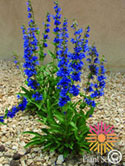 Grand Mesa Beardtongue (Penstemon mensarum) has stunning cobalt blue spikes in early spring which last for nearly two months. Its dense mats of evergreen rosettes turn a lovely orange-red in winter. This close cousin to ‘Bandera’ blooms almost a month earlier, extending the season of garden-worthy blue penstemons. Grand Mesa beardtongue is found only in Western Colorado in the wild, but grows well in sunny, moderate to dry gardens and landscapes in USDA zones 3-9 (up to 9,000’). Grand Mesa beardtongue grows 24-30” tall and 10-15” wide, blooming April to June, and is adaptable to loamy, sandy or clay soils.
Grand Mesa Beardtongue (Penstemon mensarum) has stunning cobalt blue spikes in early spring which last for nearly two months. Its dense mats of evergreen rosettes turn a lovely orange-red in winter. This close cousin to ‘Bandera’ blooms almost a month earlier, extending the season of garden-worthy blue penstemons. Grand Mesa beardtongue is found only in Western Colorado in the wild, but grows well in sunny, moderate to dry gardens and landscapes in USDA zones 3-9 (up to 9,000’). Grand Mesa beardtongue grows 24-30” tall and 10-15” wide, blooming April to June, and is adaptable to loamy, sandy or clay soils.
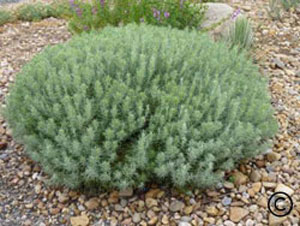
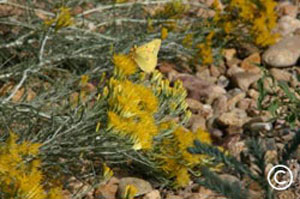 Baby blue rabbitbrush (Chrysothamnus [Ericameria] nauseosus var. nauseosus) Dwarf forms of rabbitbrush occur everywhere in the West, but this compact, dome-like strain found along the Front Range is especially dense and silvery-blue with bright golden flowers in late summer and fall. This indispensible and indestructible native offers multi-season interest, growing 16-28” tall, 20-30” wide, and blooming September through November. Baby blue rabbitbrush prefers full sun to part shade in sandy, clay or loam soils. Once established, it will need no additional moisture, but can tolerate moderate water conditions, as well. Hardy in USDA zones 4-9 (up to 8,000’).
Baby blue rabbitbrush (Chrysothamnus [Ericameria] nauseosus var. nauseosus) Dwarf forms of rabbitbrush occur everywhere in the West, but this compact, dome-like strain found along the Front Range is especially dense and silvery-blue with bright golden flowers in late summer and fall. This indispensible and indestructible native offers multi-season interest, growing 16-28” tall, 20-30” wide, and blooming September through November. Baby blue rabbitbrush prefers full sun to part shade in sandy, clay or loam soils. Once established, it will need no additional moisture, but can tolerate moderate water conditions, as well. Hardy in USDA zones 4-9 (up to 8,000’).
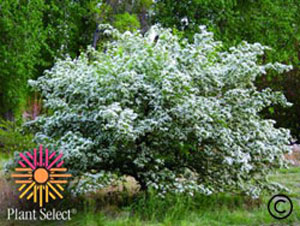
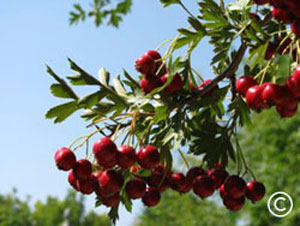 Russian hawthorn (Crataegus ambigua) is another gem which traces its origins in American horticulture to the Cheyenne Experiment Station. This nearly perfect small tree has gorgeous bark and deep green, ferny foliage. White flowers appear in April and May, followed by glistening red fruit in fall (beloved of birds) and brilliant, gold fall color. Russian hawthorn grows 12-24’ tall and 6-12’ wide, and tolerates a wide range of light (full sun to part shade), moisture (moderate to xeric) and soil (sandy, clay or loam) conditions. Hardy to USDA zones 4-9 (up to 8,000’), Russian hawthorn is an underutilized tree, although it has been treasured by keen gardeners in the Front Range for many years.
Russian hawthorn (Crataegus ambigua) is another gem which traces its origins in American horticulture to the Cheyenne Experiment Station. This nearly perfect small tree has gorgeous bark and deep green, ferny foliage. White flowers appear in April and May, followed by glistening red fruit in fall (beloved of birds) and brilliant, gold fall color. Russian hawthorn grows 12-24’ tall and 6-12’ wide, and tolerates a wide range of light (full sun to part shade), moisture (moderate to xeric) and soil (sandy, clay or loam) conditions. Hardy to USDA zones 4-9 (up to 8,000’), Russian hawthorn is an underutilized tree, although it has been treasured by keen gardeners in the Front Range for many years.
The mission of Plant Select® is to seek out and distribute the best plants for landscapes from the High Plains to the Intermountain region and beyond. To be included in the program, selected plants should:
- Thrive in a broad range of garden situations in the Rocky Mountain region
- be resilient to the region’s challenging climate
- Exemplify the unique
- Demonstrate disease and insect resistance
- Flourish in low water conditions
- Display a long season of beauty in the garden
- Ensure noninvasiveness
For all the Plant Selecté recommendations, see plantselect.org.



